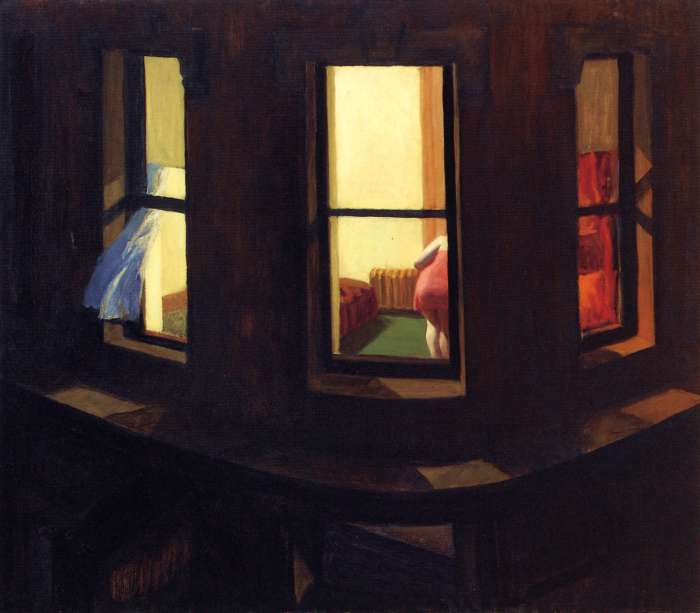
Night Windows
Edward Hopper, 1928

Night Windows
Edward Hopper, 1928
At the New York School of Art, where Hopper was enrolled from 1900 to 1905, his teacher Robert Henri told his students: “Low art is just telling things; as, There is the night. High art gives the feel of the night. The latter is nearer reality although the former is a copy.” Night Windows is one among many of Hopper’s paintings that show how thoroughly he had absorbed this precept.
Returning to the United States in 1907 from his first trip to Paris, Hopper found it “a chaos of ugliness”; nevertheless, it was the contemporary American city that he was to make his particular theme. He did not perceive New York astir with human activity, like Henri, admire the dynamism of its traffic and skyscrapers, like Marin, or distill its structures into abstract patterns, like the Precisionists. Instead, he was interested in the forms and materials of the city’s streets and buildings—stone, brick, asphalt, steel, and glass—and the effect of light falling upon them. Light was the most powerful and personal of Hopper’s expressive means. He used it as an active element in his paintings to model forms, define the time of day, establish a mood, and create pictorial drama by contrasting it with areas of shadow and darkness.
An instructive comparison was drawn by Alfred H. Barr, Jr. between Hopper’s Night Windows and an etching of 1910 with the same title by John Sloan, a member with Henri of the so-called Ashcan School. In the engraving, “One looks from a fire escape into the disorderly windows of a tenement in which figures are busy opening sashes, shouting, undressing, hanging clothes to dry; the print teems with casual humanity. In Hopper’s oil of the same subject, there are three windows, three brilliant rectangles, framed by the black walls as symmetrically as a triptych. In spite of one half-seen figure there grows as one studies this curious picture an impression of silent immobility. The drifting curtain...[is] evocative to a degree beyond [its] visual importance.” As James Thrall Soby has noted, “In numerous paintings...Hopper has used the flutter of curtains as a sign of heartbeat in the coma-like silence of his images.”
In the 1920s and 1930s Hopper was an enthusiastic theater-goer. The continuous curve of the outer sill in the foreground of Night Windows is like the edge of a stage beyond which the scene within the room unfolds. Many of Hopper’s paintings use the compositional device of an interior with a nude or half-dressed woman glimpsed through a window by an unseen viewer who looks in from outside. The impression conveyed, however, is not one of prurient voyeurism but rather of loneliness and isolation. Engaged in a private act, the woman is unaware of the spectator; despite their proximity, each leads a life entirely separate from the other.
Hopper once declared, “My aim in painting has always been the most exact transcription possible of my most intimate impressions of nature.” The operative words here are “my most intimate impressions”; to quote Lloyd Goodrich, “In exactly conveying the mood of these particular places and hours, Hopper’s art transcended realism and became highly personal poetry.” Though the figures in his pictures engage in mundane activities, and the settings are commonplace, he paints them in a way that invests them with an underlying sense of mystery.
—from An Invitation to See: 150 Works from The Museum of Modern Art, by Helen M. Franc